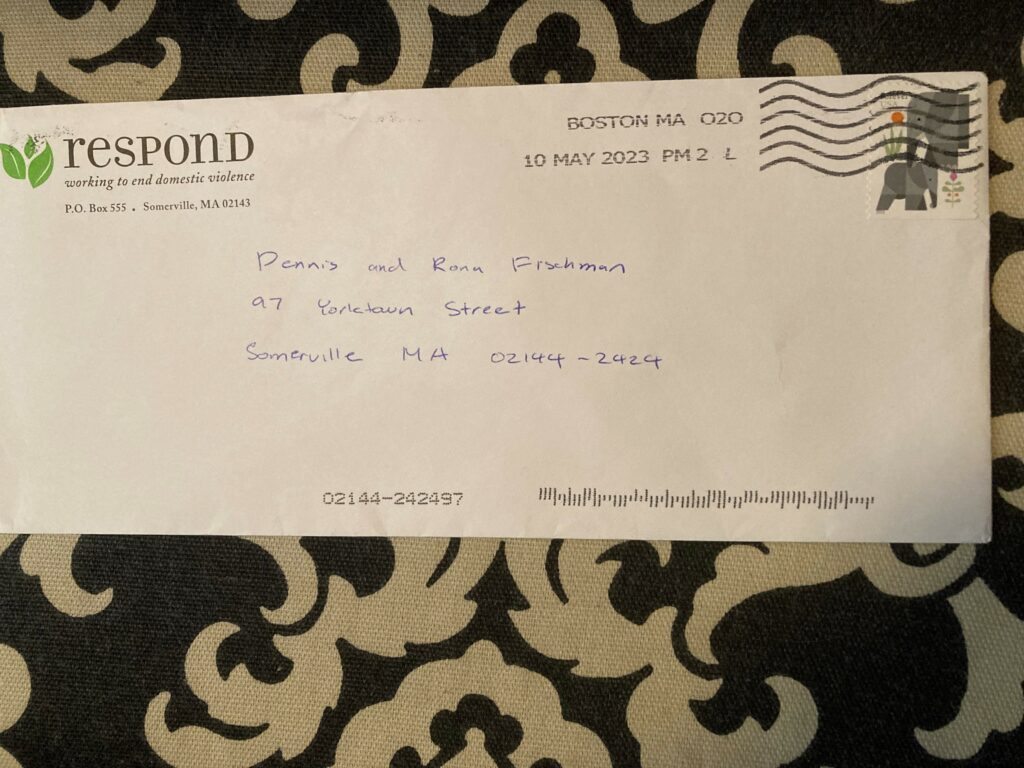At the beginning of January, you heard from me about thirteen things nonprofits should STOP doing in their fundraising appeals. When you see a good example, though, please jump right in and do the same!
My first good example for you: RESPOND, New England’s first domestic violence agency and the second oldest in the nation. Both in their Spring and End of Year appeal letters, this nonprofit did things that are guaranteed to make their donors…well…respond!
It starts with the envelope
RESPOND did three things that, before donors even opened the envelope, made it more likely they would read their message.
- Used a live stamp–a cute picture of a mama elephant and her baby–not a rubber stamp.
- Put their name, logo, and slogan (“Working to end domestic violence”) in the reply address. I knew who was sending me the message!
- Hand-wrote my name and my wife’s name in the address, and spelled the names right.
Last year, did your envelopes welcome the potential donors in to read your message? This year, could you borrow these three techniques from RESPOND?
The photos catch the eye
 Back in May, the letter featured the photo of a young mother cradling a newborn infant in her arms.
Back in May, the letter featured the photo of a young mother cradling a newborn infant in her arms.
It’s touching. It’s beautifully composed: your eye follows the mother’s face to the baby’s, to her flowing hair, back to her face and then to the body of the letter. And it introduces the story that’s going to be told in that letter: about raising children in a safe space.
 The letter that came out just after Thanksgiving shows the picture of a different woman, in her middle years, hugging herself, with a sad expression, but looking directly at you, the reader.
The letter that came out just after Thanksgiving shows the picture of a different woman, in her middle years, hugging herself, with a sad expression, but looking directly at you, the reader.
It, too, introduces one person’s story: a woman who had left her abusive husband but now faced the possibility of being evicted and out on the street.
(Notice that RESPOND didn’t try to talk about both women and their needs in one letter. They knew that a single story is more powerful, and they chose one story, one photo, at a time.)
These photos mattered. They didn’t replace the words, but they made me, the donor, want to read the words. Did you do that for your donors?
They had me at hello
If I think about it, I’ve never really had a safe place. I’ve been on my own pretty much from the beginning. I’ve had to raise myself.
If you saw the photo of the woman with the newborn baby and read these words, how would you feel? Would your heart go out to her?
The Spring appeal started with those two elements, that photo of a woman called Nicole and this quotation in her own words. As a reader, I wanted to hear her story. As a donor, I wanted to help.
“I thought I was doing everything right.”
When Priscilla walked into the RESPOND office this fall, her hands and her voice were shaking….
The End of Year appeal began that way, and again, it gripped me. Immediately, I was in the middle of the action, with a woman in trouble. I was looking for a way to help her–and RESPOND was right there.
Does the opening of your appeal letter make your donors want to know more, and to help?
Things get worse before they get better
Nicole married young. Her husband got laid off from work when the pandemic hit. He started to hit her. “And then, Nicole discovered she was pregnant.”
Priscilla made the hard, brave decision to leave her husband. He harassed her at her new place until she got a restraining order. Then, she came down with pneumonia. She was out of work for weeks, and the medical bills started to pile up. “She was holding a 14-day Notice to Quit–the first step to eviction proceedings.”
RESPOND made it clear just how bad things can get for women like Nicole or Priscilla. That made it urgent for me, the donor, to give.
Is your nonprofit showing the dire need for help and making the donor the hero of the story?
Don’t stop there
Research shows that your donors are more likely to look at their name, the first line, the photo, and the postscript than they are to read anything else. RESPOND knew that. They used the P.S. to call the reader to action.
P.S. Thank you for supporting RESPOND this Mother’s Day! Visit respondinc.org/donate (or point your smartphone camera at the square below) to get started.
Is your nonprofit getting the last word? Can you use a P.S. to get a better response on your next appeal letter?



